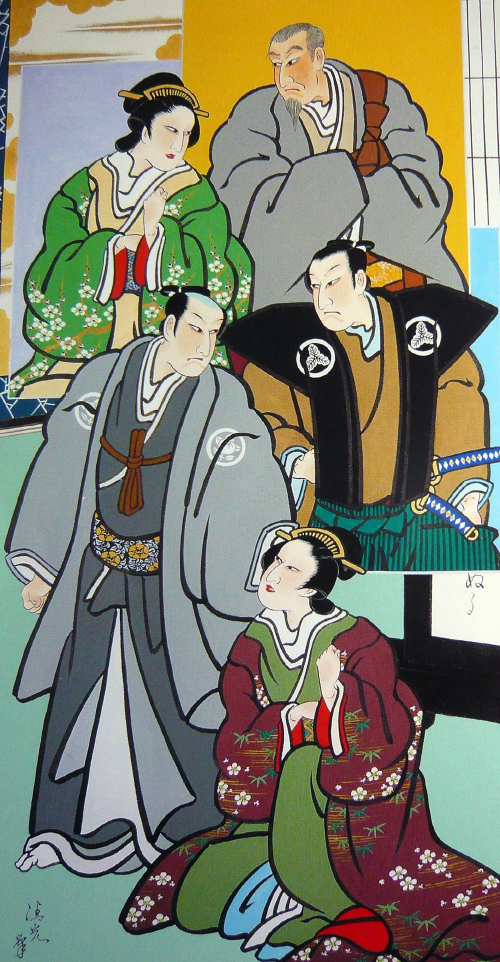| II TAIRÔ |
| Play title | Ii Tairô |
| Author | Hôjô Hideji |
| History |
Hôjô Hideji's drama "Ii Tairô" was premiered in Kabuki [1] in March 1956 at the Meijiza [more details]. |
| Structure |
The current standard version of "Ii Tairô" is made up of two acts, divided into four scenes. |
| Key words |
Ansei Ansei no Taigoku Bakumatsu Daimyô Edo-jô Hikone-jô Ii Naosuke Ômi Sakurada-mon Sakurada-mon no Hen Seishitsu Shimoyashiki Shinkabuki Sokushitsu Tairô Zenji |
| Summary |
Act I, scene 1: An Inner Room at Ii Naosuke's Mansion The harshness of Ii Naosuke's Ansei Purge against the imperialist conspirators has turned many people against him and now his life is in constant danger. As a result, his wife Masako-no-Kata is full of apprehension for his safety. She is Naosuke's legal wife (seishitsu), but is too young and naive to be versed in the affairs of state that so concern her husband. Actually, she is Naosuke's second wife, and his current mistress Oshizu-no-Kata was his first wife from the early days long before he attained his current high status. Consequently, there is a strong and understanding love between Naosuke and Oshizu-no-Kata, but a high rank necessitated a wife equal to that rank, and Naosuke in the custom of those days was forced to take young Masako-no-Kata of higher birth as his legal wife and demote Oshizu-no-Kata to the rank of official concubine (sokushitsu). Due to the turbulence of the times, marked by ominous comets, repeated cases of arson in Edo and the conspiracies of the loyalists who plan to assassinate Naosuke, the tairô of the Tokugawa Shogunate has been unable to visit the sickbed of his daughter Princess Tsuru despite the urgings of Oshizu-no-Kata, the mother of the child. Act I, scene 2: Beside the Moat near Sakurada Gate Just around this time, one of his childhood friends, Minabe Mutsuomi [2], is arrested as an imperialist rebel. He is seriously wounded. Naosuke gets rid of the samurai guarding the prisoner and faces him. On having his ropes loosened, Mutsuomi tries to cut down Naosuke, but his body can't respond. As a loyalist, Mutsuomi should oppose Naosuke, but he has been in awe of Naosuke's obstinacy from a long time ago. Due to the outrageous Ansei Purge, Mutsuomi implores Naosuke to step down from his position and return power to the Imperial Court. Naosuke explains his own position and the true feelings of the emperor and points out that many of the loyalist factions, though ostensibly acting out of reverence for the emperor, are actually motivated only by personal ambition. Act I, scene 3: Back to the Inner Room When Naosuke returns to his official residence [3] and hears of Princess Tsuru's condition, he attempts to go to his unofficial residence [4], his shimoyashiki in Sendagaya, but is urged to act prudently by Utsugi Rokunojô due to disquieting movements outside. Masako-no-Kata goes in his place. Naosuke consults his retainer Nagano Shuzen as to whether it would be possible to reduce the sentences of the young men who were incited to take part in the rebellion. Shuzen replies that, though he understands Naosuke's feelings, the executions cannot be stayed. While Naosuke is thus being made to think deeply about human life, news of Princess Tsuru's death is brought to him. Act II, scene 1: A Room in Oshizu-no-Kata's Residence At Ii Naosuke's unofficial residence [4] (shimoyashiki), special memorial services are being held by the visiting zenji Sen'ei for Princess Tsuru, Naosuke's daughter by Oshizu-no-Kata, who died the previous year. It is the time of the Doll Festival and in the room the lovely little dolls are on display. Although it is already spring, the day is unusually cold. Oshizu-no-Kata is living now in comfort attended by many servants, but she is lonely being separated from Naosuke. Sen'ei is a friend from the old days, so she can speak her heart to him. As Sen'ei is enjoying his cup of tea, his eyes happen to fall on a poem which has been written by Naosuke. Quietly he tells Oshizu-no-Kata that Naosuke may soon leave this world, for the calligraphic writing on the poem reveals the danger of sudden and violent death. It is at this moment that Naosuke himself arrives on an unexpected visit. The attendants as well as Oshizu-no-Kata are overjoyed and prepare to greet him, while Sen'ei quietly leaves the room to allow Oshizu-no-Kata a private meeting with her husband. Oshizu-no-Kata, forgetting all her loneliness and fears of a moment ago, happily greets her husband. But in spite of their happiness at being together, neither can quite shake off the feeling of uncertainty and sadness. Oshizu-no-Kata makes every effort to comfort Naosuke in his loneliness and bitterness, telling him that it does not matter what the whole world should think or say, if only he acts as his own conscience dictates. Naosuke, who is somehow conscious of the approach of death [5], is comforted by her gentle words and her faith in him. The two embrace, fully aware that it may be for the last time. Outside spring snow begins to fall. |
| Notes |
[1] It was premiered in October 1953 at the Meijiza with a non-Kabuki troupe. [2] Minabe Mutsuomi later commits suicide, leaving a will pleading for clemency for his young colleagues. [3] The mansion where Masako-no-Kata lives. [4] The mansion where Oshizu-no-Kata lives. [5] It was on the following morning as he was making his way to the Edo Castle that Ii Naosuke was assassinated at Sakurada Gate. |
 |
|
"Ii Tairô" |
|
|
| Contact | Main | Top | Updates | Actors | Plays | Playwrights | Programs | Links | FAQ | Glossary | Chronology | Illustrations | Prints | Characters | Derivatives | Theaters | Coming soon | News |